Page 67 of 570

66 Getting started
Parking and locking
Parking brake
1Parking brake pedal
2Release handle�Step firmly on parking brake pedal1.
When the engine is running, the warn-
ing lamp; (USA only) or3
(Canada only) in the instrument cluster
comes on.
Switching off headlamps
�Turn the exterior lamp switch toM.
For more information, see “Lighting”
(
�page 146).
Warning!G
Engaging the parking brake while the vehicle
is in motion can cause the rear wheels to
lock up. You could lose control of the vehicle
and cause an accident. In addition, the
vehicle’s brake lights do not light up when
the parking brake is engaged. Make sure not
to endanger any other road users when you
engage the parking brake.
Warning!G
When leaving the vehicle, always remove the
SmartKey or SmartKey with KEYLESS-GO*
from the starter switch, take it with you and
lock the vehicle. Do not leave children
unattended in the vehicle, or with access
to an unlocked vehicle. Children could
release the parking brake and/or shift the
automatic transmission out of positionP,
either of which could result in an accident
and/or serious personal injury.
Warning!G
Getting out of your vehicle with the auto-
matic transmission not fully engaged in
positionP is dangerous. Also, when parked
on an incline, positionP alone may not
prevent your vehicle from moving, possibly
hitting people or objects.
Always set the parking brake in addition to
shifting to positionP (
�page 199).
When parked on an incline, also turn front
wheel towards the road curb.
Page 73 of 570
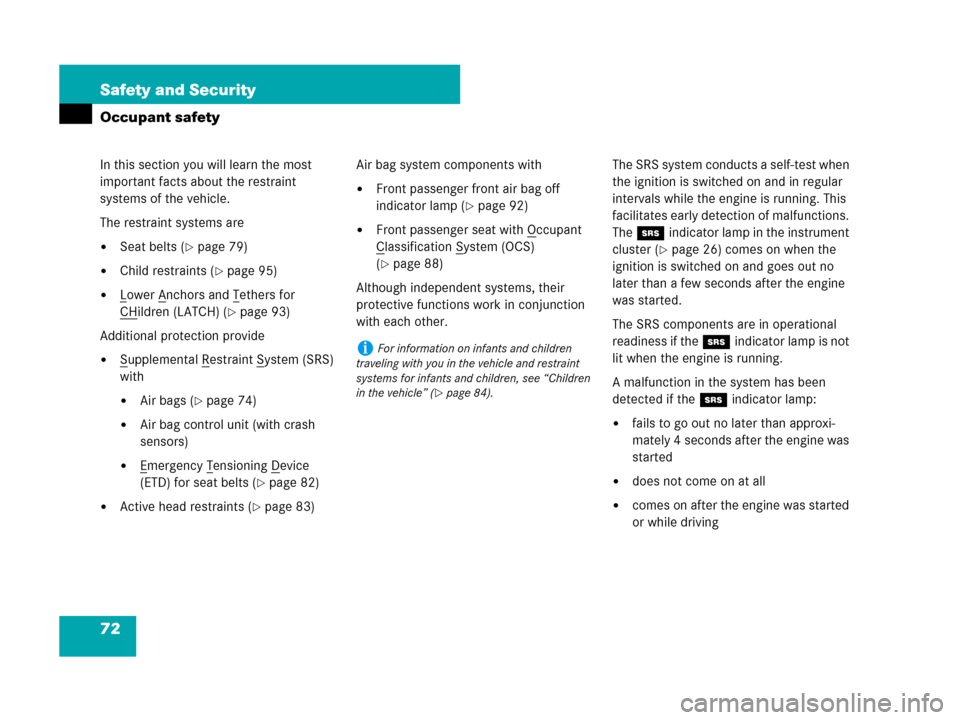
72 Safety and Security
Occupant safety
In this section you will learn the most
important facts about the restraint
systems of the vehicle.
The restraint systems are
�Seat belts (�page 79)
�Child restraints (�page 95)
�Lower Anchors and Tethers for
CH
ildren (LATCH) (�page 93)
Additional protection provide
�Supplemental Restraint System (SRS)
with
�Air bags (�page 74)
�Air bag control unit (with crash
sensors)
�Emergency Tensioning Device
(ETD) for seat belts (
�page 82)
�Active head restraints (�page 83)Air bag system components with
�Front passenger front air bag off
indicator lamp (
�page 92)
�Front passenger seat with Occupant
C
lassification System (OCS)
(
�page 88)
Although independent systems, their
protective functions work in conjunction
with each other.The SRS system conducts a self-test when
the ignition is switched on and in regular
intervals while the engine is running. This
facilitates early detection of malfunctions.
The 1indicator lamp in the instrument
cluster (
�page 26) comes on when the
ignition is switched on and goes out no
later than a few seconds after the engine
was started.
The SRS components are in operational
readiness if the 1indicator lamp is not
lit when the engine is running.
A malfunction in the system has been
detected if the 1indicator lamp:
�fails to go out no later than approxi-
mately 4 seconds after the engine was
started
�does not come on at all
�comes on after the engine was started
or while driving
iFor information on infants and children
traveling with you in the vehicle and restraint
systems for infants and children, see “Children
in the vehicle” (
�page 84).
Page 101 of 570
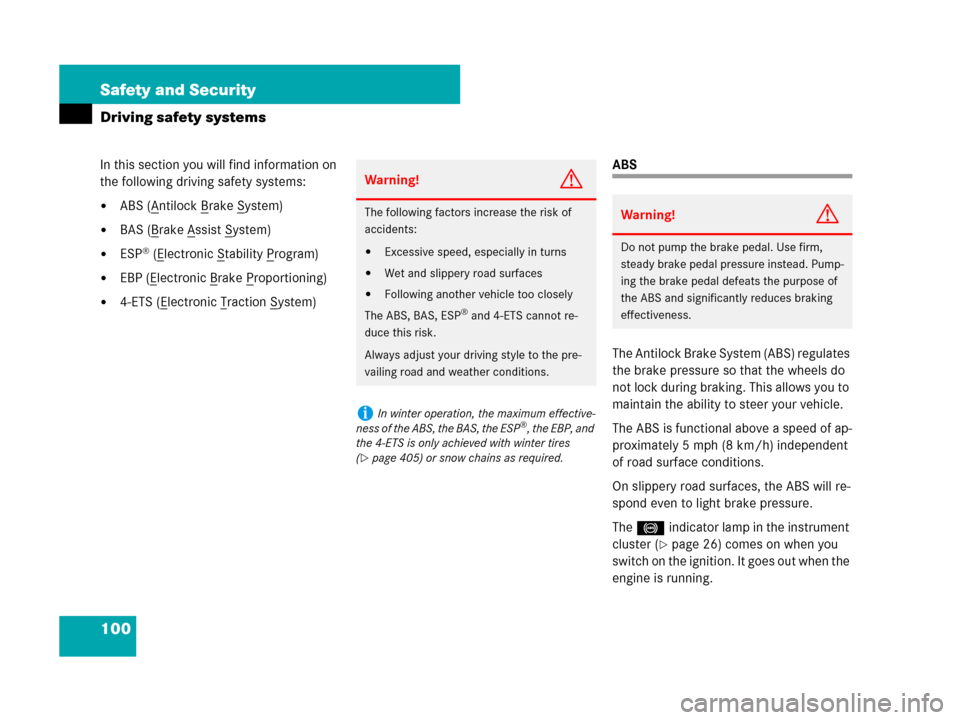
100 Safety and Security
Driving safety systems
In this section you will find information on
the following driving safety systems:
�ABS (Antilock Brake System)
�BAS (Brake Assist System)
�ESP® (Electronic Stability Program)
�EBP (Electronic Brake Proportioning)
�4-ETS (Electronic Traction System)
ABS
The Antilock Brake System (ABS) regulates
the brake pressure so that the wheels do
not lock during braking. This allows you to
maintain the ability to steer your vehicle.
The ABS is functional above a speed of ap-
proximately 5 mph (8 km/h) independent
of road surface conditions.
On slippery road surfaces, the ABS will re-
spond even to light brake pressure.
The -indicator lamp in the instrument
cluster (
�page 26) comes on when you
switch on the ignition. It goes out when the
engine is running.
Warning!G
The following factors increase the risk of
accidents:
�Excessive speed, especially in turns
�Wet and slippery road surfaces
�Following another vehicle too closely
The ABS, BAS, ESP
® and 4-ETS cannot re-
duce this risk.
Always adjust your driving style to the pre-
vailing road and weather conditions.
iIn winter operation, the maximum effective-
ness of the ABS, the BAS, the ESP®, the EBP, and
the 4-ETS is only achieved with winter tires
(
�page 405) or snow chains as required.
Warning!G
Do not pump the brake pedal. Use firm,
steady brake pedal pressure instead. Pump-
ing the brake pedal defeats the purpose of
the ABS and significantly reduces braking
effectiveness.
Page 105 of 570
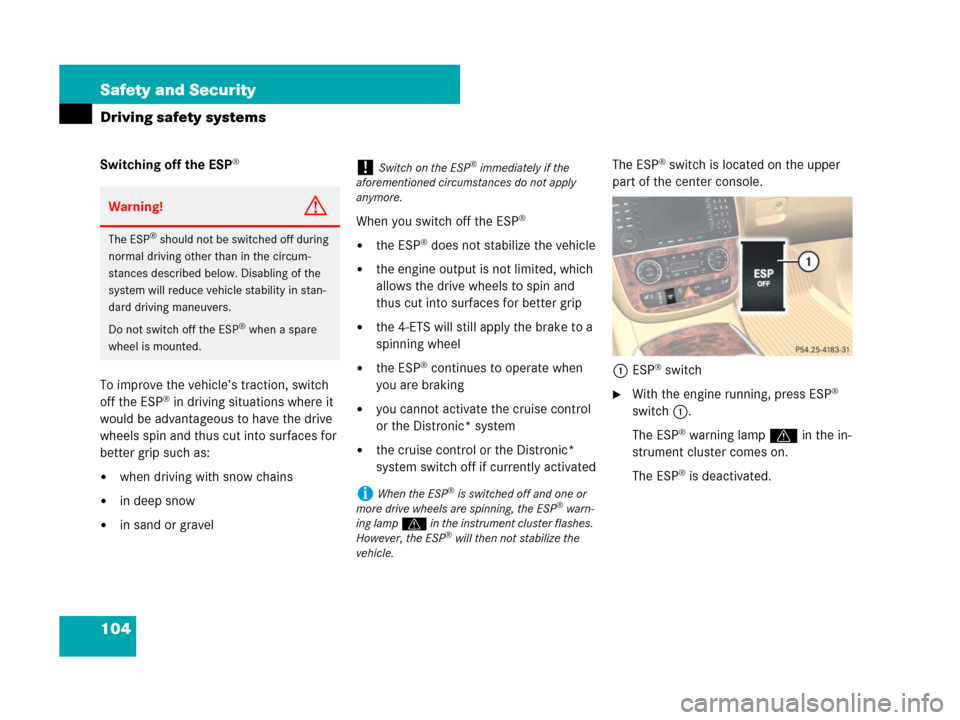
104 Safety and Security
Driving safety systems
Switching off the ESP®
To improve the vehicle’s traction, switch
off the ESP® in driving situations where it
would be advantageous to have the drive
wheels spin and thus cut into surfaces for
better grip such as:
�when driving with snow chains
�in deep snow
�in sand or gravelWhen you switch off the ESP
®
�the ESP® does not stabilize the vehicle
�the engine output is not limited, which
allows the drive wheels to spin and
thus cut into surfaces for better grip
�the 4-ETS will still apply the brake to a
spinning wheel
�the ESP® continues to operate when
you are braking
�you cannot activate the cruise control
or the Distronic* system
�the cruise control or the Distronic*
system switch off if currently activatedThe ESP
® switch is located on the upper
part of the center console.
1ESP
® switch
�With the engine running, press ESP®
switch1.
The ESP
®warning lampv in the in-
strument cluster comes on.
The ESP
® is deactivated.
Warning!G
The ESP® should not be switched off during
normal driving other than in the circum-
stances described below. Disabling of the
system will reduce vehicle stability in stan-
dard driving maneuvers.
Do not switch off the ESP
® when a spare
wheel is mounted.
!Switch on the ESP® immediately if the
aforementioned circumstances do not apply
anymore.
iWhen the ESP® is switched off and one or
more drive wheels are spinning, the ESP® warn-
ing lamp v in the instrument cluster flashes.
However, the ESP
® will then not stabilize the
vehicle.
Page 106 of 570
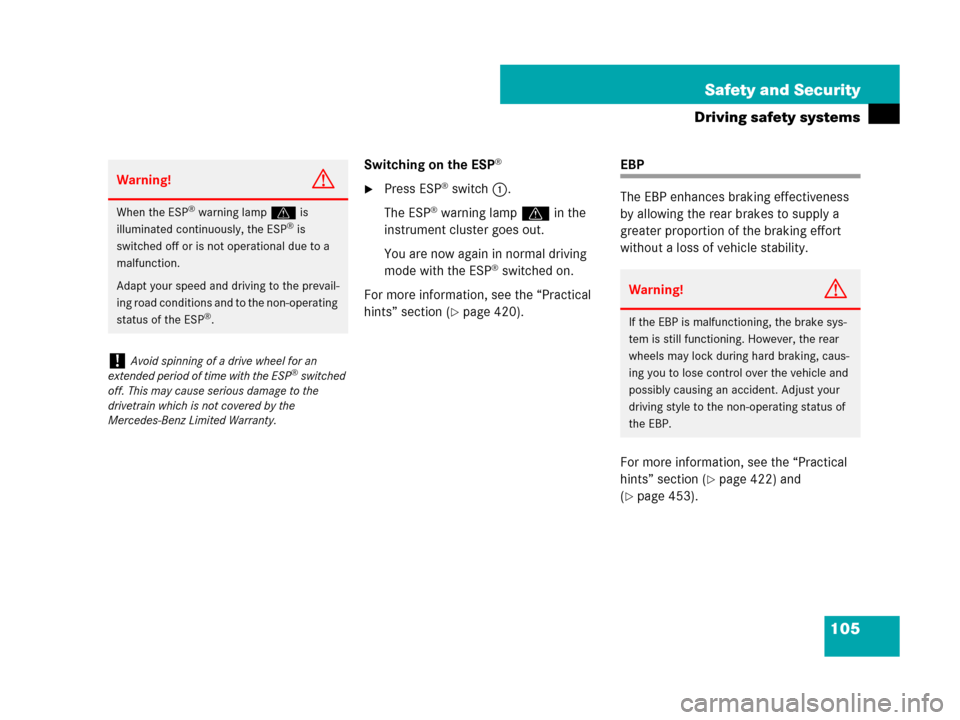
105 Safety and Security
Driving safety systems
Switching on the ESP®
�Press ESP® switch1.
The ESP
® warning lampv in the
instrument cluster goes out.
You are now again in normal driving
mode with the ESP
® switched on.
For more information, see the “Practical
hints” section (
�page 420).
EBP
The EBP enhances braking effectiveness
by allowing the rear brakes to supply a
greater proportion of the braking effort
without a loss of vehicle stability.
For more information, see the “Practical
hints” section (
�page 422) and
(
�page 453).
Warning!G
When the ESP® warning lampv is
illuminated continuously, the ESP® is
switched off or is not operational due to a
malfunction.
Adapt your speed and driving to the prevail-
ing road conditions and to the non-operating
status of the ESP
®.
!Avoid spinning of a drive wheel for an
extended period of time with the ESP® switched
off. This may cause serious damage to the
drivetrain which is not covered by the
Mercedes-Benz Limited Warranty.
Warning!G
If the EBP is malfunctioning, the brake sys-
tem is still functioning. However, the rear
wheels may lock during hard braking, caus-
ing you to lose control over the vehicle and
possibly causing an accident. Adjust your
driving style to the non-operating status of
the EBP.
Page 107 of 570
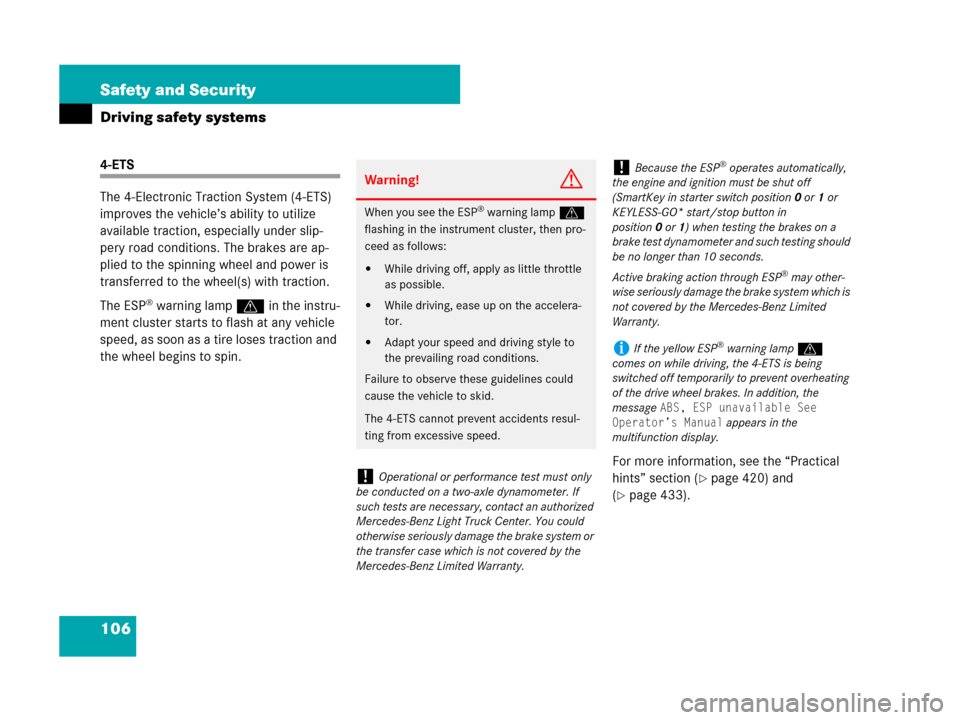
106 Safety and Security
Driving safety systems
4-ETS
The 4-Electronic Traction System (4-ETS)
improves the vehicle’s ability to utilize
available traction, especially under slip-
pery road conditions. The brakes are ap-
plied to the spinning wheel and power is
transferred to the wheel(s) with traction.
The ESP
® warning lampvin the instru-
ment cluster starts to flash at any vehicle
speed, as soon as a tire loses traction and
the wheel begins to spin.
For more information, see the “Practical
hints” section (
�page 420) and
(
�page 433).
Warning!G
When you see the ESP® warning lampv
flashing in the instrument cluster, then pro-
ceed as follows:
�While driving off, apply as little throttle
as possible.
�While driving, ease up on the accelera-
tor.
�Adapt your speed and driving style to
the prevailing road conditions.
Failure to observe these guidelines could
cause the vehicle to skid.
The 4-ETS cannot prevent accidents resul-
ting from excessive speed.
!Operational or performance test must only
be conducted on a two-axle dynamometer. If
such tests are necessary, contact an authorized
Mercedes-Benz Light Truck Center. You could
otherwise seriously damage the brake system or
the transfer case which is not covered by the
Mercedes-Benz Limited Warranty.
!Because the ESP® operates automatically,
the engine and ignition must be shut off
(SmartKey in starter switch position0 or1 or
KEYLESS-GO* start/stop button in
position0or1) when testing the brakes on a
brake test dynamometer and such testing should
be no longer than 10 seconds.
Active braking action through ESP
® may other-
wise seriously damage the brake system which is
not covered by the Mercedes-Benz Limited
Warranty.
iIf the yellow ESP® warning lampv
comes on while driving, the 4-ETS is being
switched off temporarily to prevent overheating
of the drive wheel brakes. In addition, the
message
ABS, ESP unavailable See
Operator’s Manual
appears in the
multifunction display.
Page 112 of 570
111 Controls in detail
Locking and unlocking
Seats
Memory function*
Lighting
Instrument cluster
Control system
Automatic transmission
Good visibility
Climate control
3-zone automatic climate control*
Power windows
Power tilt/sliding sunroof*
Panorama roof with power tilt/slid-
ing panel*
Driving systems
Loading
Useful features
Page 151 of 570
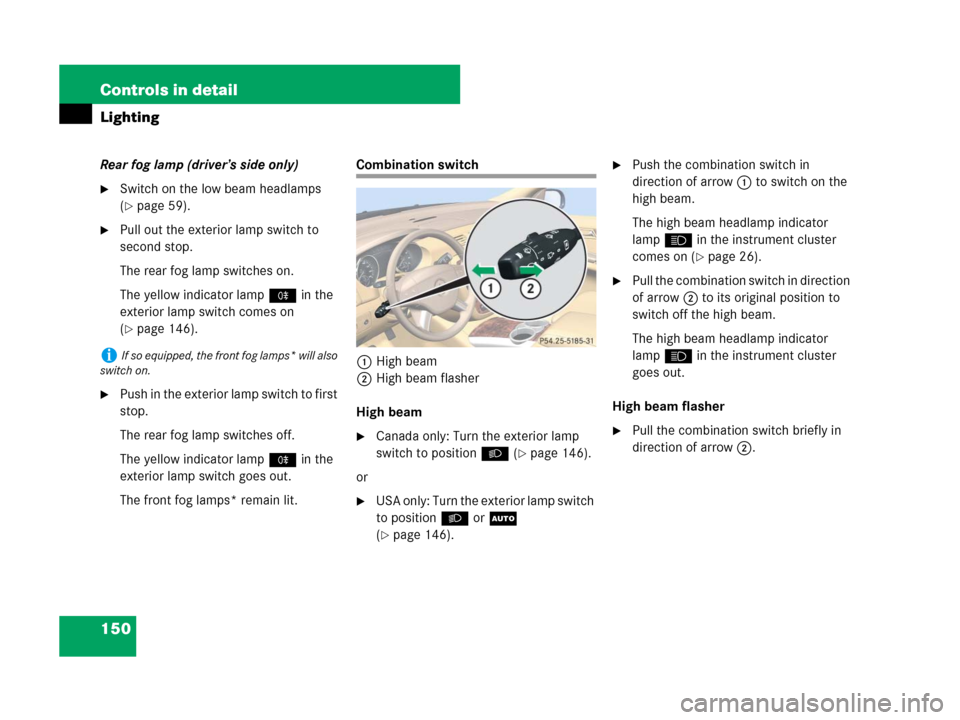
150 Controls in detail
Lighting
Rear fog lamp (driver’s side only)
�Switch on the low beam headlamps
(
�page 59).
�Pull out the exterior lamp switch to
second stop.
The rear fog lamp switches on.
The yellow indicator lamp† in the
exterior lamp switch comes on
(
�page 146).
�Push in the exterior lamp switch to first
stop.
The rear fog lamp switches off.
The yellow indicator lamp† in the
exterior lamp switch goes out.
The front fog lamps* remain lit.
Combination switch
1High beam
2High beam flasher
High beam
�Canada only: Turn the exterior lamp
switch to positionB (
�page 146).
or
�USA only: Turn the exterior lamp switch
to positionB orU
(
�page 146).
�Push the combination switch in
direction of arrow1 to switch on the
high beam.
The high beam headlamp indicator
lampAin the instrument cluster
comes on (
�page 26).
�Pull the combination switch in direction
of arrow2 to its original position to
switch off the high beam.
The high beam headlamp indicator
lampAin the instrument cluster
goes out.
High beam flasher
�Pull the combination switch briefly in
direction of arrow2.
iIf so equipped, the front fog lamps* will also
switch on.